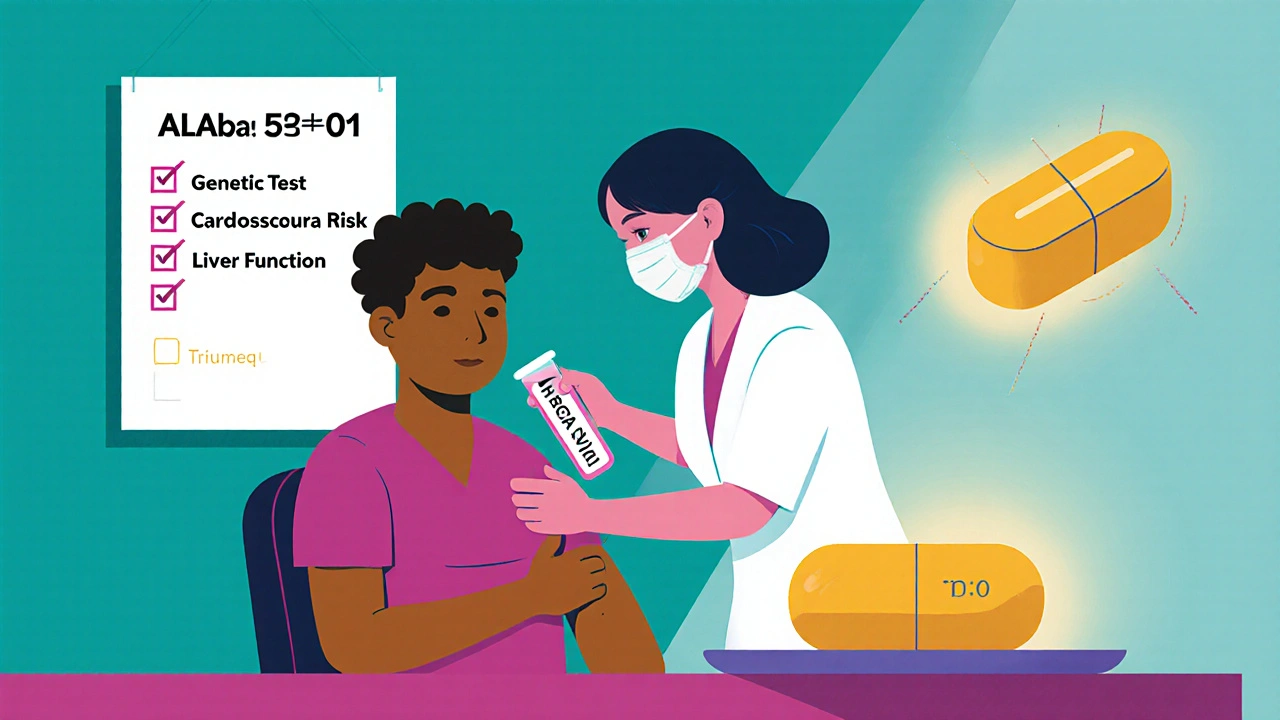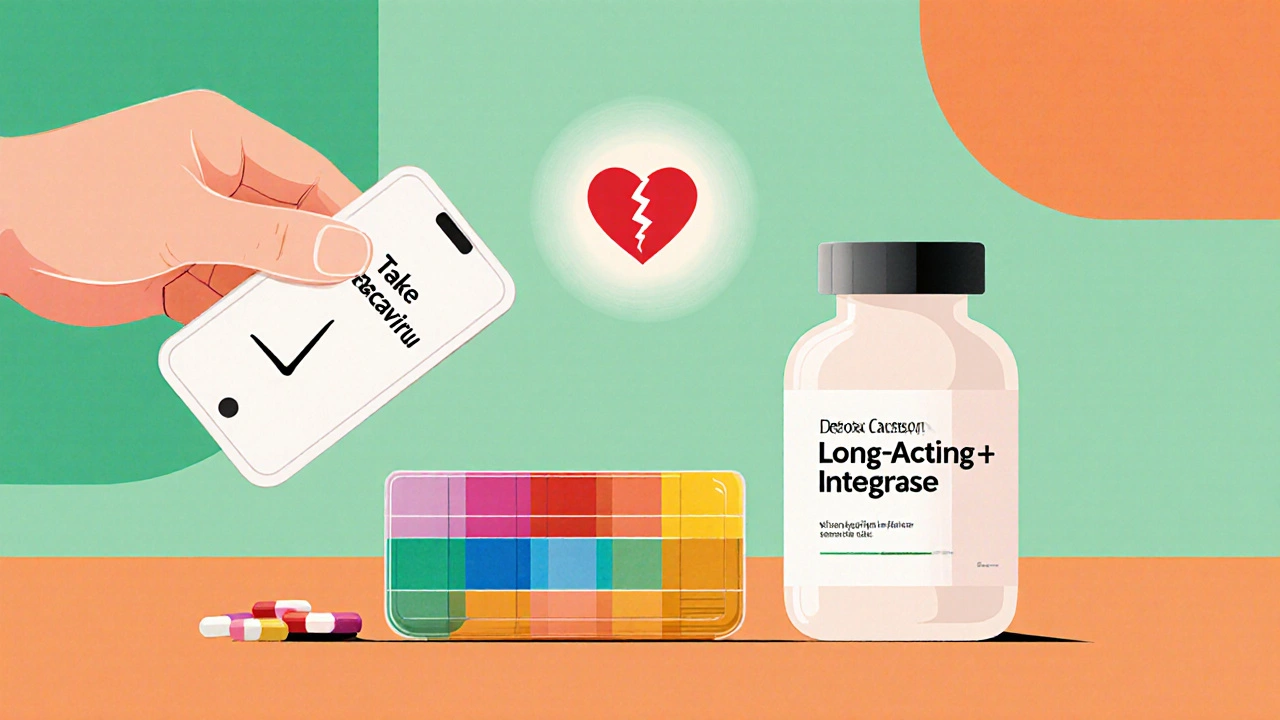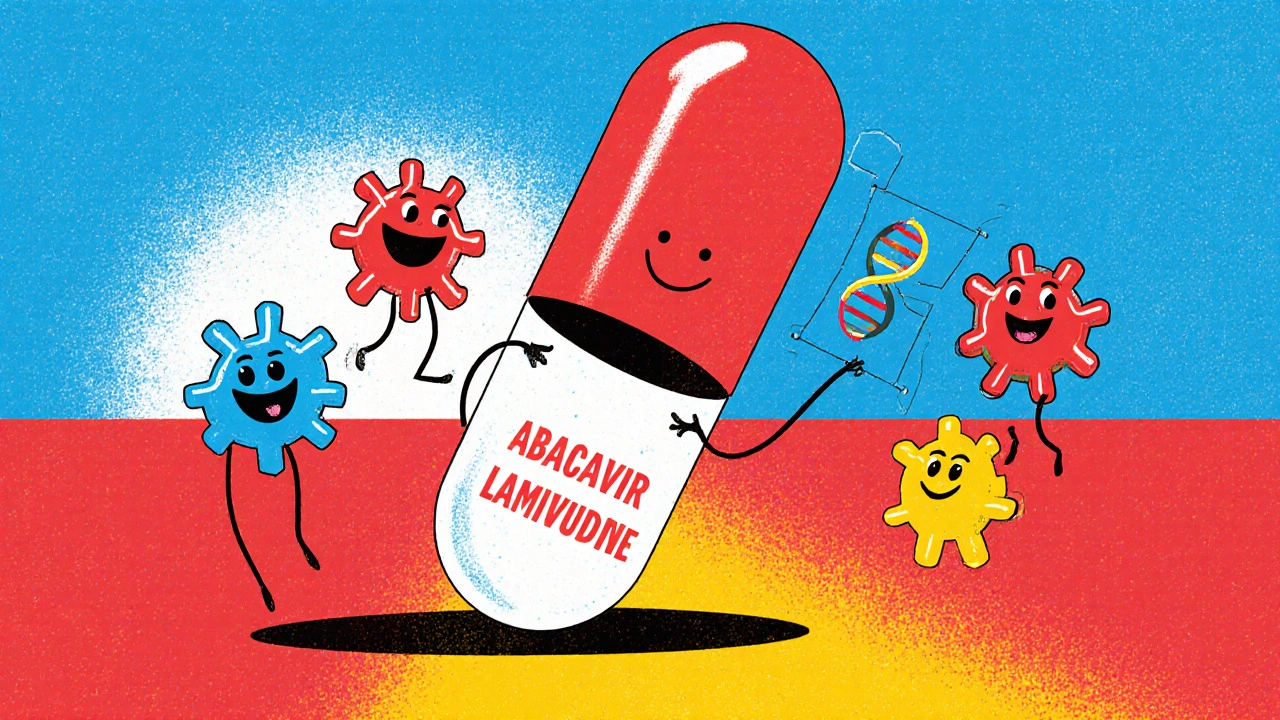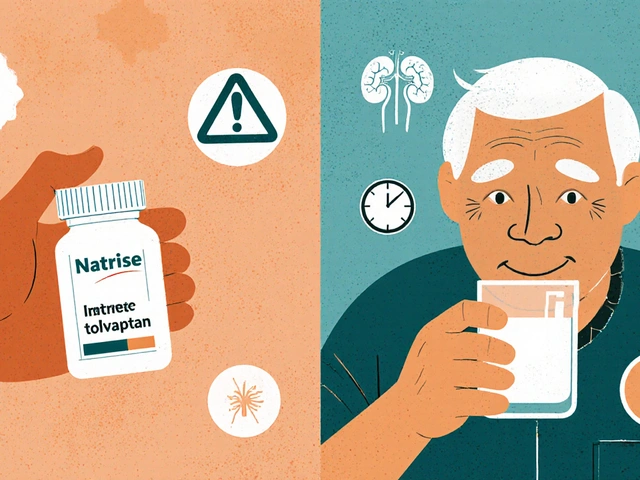HLA-B*57:01 Screening Decision Tool
Abacavir Screening Requirements
This tool helps determine if HLA-B*57:01 genetic testing is required before starting abacavir. Based on 2024 DHHS guidelines.
Results will appear here after calculation
Abacavir is a nucleoside reverse transcriptase inhibitor (NRTI) that has become a staple in modern combination antiretroviral therapy (cART) for HIV‑1 infection. When paired with other classes-integrase strand transfer inhibitors, non‑nucleoside reverse transcriptase inhibitors, or protease inhibitors-abacavir helps keep viral loads undetectable while offering a tolerable side‑effect profile for many patients.
Why Abacavir Is Used in Multi‑Drug Regimens
Abacavir’s strength lies in its high genetic barrier to resistance and its once‑daily dosing convenience. In the 2024 DHHS HIV treatment guidelines, abacavir‑based combos rank alongside tenofovir alafenamide (TAF) regimens for treatment‑naïve adults, provided patients are screened for the HLA‑B*57:01 allele.
Key Patient‑Screening Steps
- Order HLA‑B*57:01 genetic testing before initiating abacavir. A positive result predicts a hypersensitivity reaction in up to 5% of patients.
- Review cardiovascular risk factors-abacavir has been linked to a modest increase in myocardial infarction risk in patients with existing heart disease.
- Assess renal and hepatic function. While abacavir is primarily metabolized by the liver, dose adjustments are rarely needed.
Common Abacavir‑Containing Regimens
| Regimen | Components | Dosage Frequency | Key Advantages | Typical Use Cases |
|---|---|---|---|---|
| Triumeq | Abacavir/lamivudine + dolutegravir | Once daily | Single‑tablet, high barrier to resistance | First‑line for treatment‑naïve adults without HLA‑B*57:01 |
| Eviplera | Abacavir/lamivudine + rilpivirine | Once daily | Avoids integrase inhibitors for patients with neuropsychiatric concerns | Patients stable on NNRTI‑based therapy |
| Abacavir/lamivudine + boosted protease inhibitor (e.g., darunavir/ritonavir) | Abacavir/lamivudine + darunavir/ritonavir | Twice daily for protease inhibitor | Robust option for patients with high viral loads or prior resistance | Second‑line after failure of an integrase regimen |
How Abacavir Works Inside the Body
Abacavir mimics the natural nucleoside guanosine. Once inside a CD4+ T‑cell, cellular kinases phosphorylate it to the active triphosphate form. This analogue is then incorporated by HIV reverse transcriptase into the growing viral DNA chain, causing premature termination.

Drug‑Drug Interactions to Watch
Because abacavir is metabolized by alcohol dehydrogenase and glucuronidation pathways, most antiretrovirals don’t affect its levels. However, certain drugs can increase toxicity:
- Rifampicin - induces glucuronidation, potentially lowering abacavir exposure; adjust dose or avoid.
- Azathioprine - additive bone‑marrow suppression; monitor complete blood count closely.
- Didanosine - overlapping mitochondrial toxicity; generally contraindicated together.
Managing Side Effects and Toxicities
Most patients tolerate abacavir well. The hallmark adverse event is hypersensitivity, which typically appears 7-10 days after starting therapy. Symptoms include fever, rash, gastrointestinal upset, and respiratory distress. Immediate discontinuation and emergency care are crucial.
Long‑term concerns revolve around cardiovascular risk. A 2023 meta‑analysis of 12 trials (over 35,000 participants) found a 12% relative increase in myocardial infarction among abacavir users with baseline high cholesterol. Practitioners should therefore:
- Screen lipid profiles before and during therapy.
- Prefer abacavir for patients with low to moderate cardiac risk.
- Consider switching to a tenofovir‑based regimen if significant atherosclerotic disease develops.
Adherence Tips for Patients on Abacavir‑Based Regimens
Since many regimens are once‑daily single‑tablet, adherence is generally high. Still, practical steps help:
- Link pill intake to a daily habit (e.g., breakfast).
- Use phone alarms or pill‑box reminders.
- Discuss side‑effect concerns early; early management prevents drop‑out.
- Encourage routine viral load testing every 3-6 months.

Future Directions: Long‑Acting and Dual‑Therapy Options
Research in 2025 is exploring injectable long‑acting formulations that combine an integrase inhibitor with an NRTI backbone. While abacavir isn’t yet part of a long‑acting depot, its excellent safety profile makes it a candidate for future combination implants.
Dual‑therapy trials (e.g., dolutegravir + lamivudine) have shown non‑inferior efficacy to triple therapy, potentially reducing exposure to abacavir’s cardiovascular risk. Clinicians should stay tuned for guideline updates that may shift the standard of care.
Key Takeaways
- Abacavir is a cornerstone NRTI in many once‑daily HIV regimens, provided HLA‑B*57:01 testing is negative.
- Typical combos include Triumeq (abacavir/lamivudine + dolutegravir) and eviplera (abacavir/lamivudine + rilpivirine).
- Monitor for hypersensitivity and cardiovascular risk; adjust therapy for high‑risk patients.
- Drug interactions are limited but avoid concurrent didanosine and watch for rifampicin.
- Adherence is boosted by single‑tablet regimens, but patient education remains essential.
Frequently Asked Questions
Do I need to be tested for HLA‑B*57:01 before starting abacavir?
Yes. The CDC and WHO recommend HLA‑B*57:01 screening because a positive result predicts a potentially life‑threatening hypersensitivity reaction. If the test is negative, abacavir can be prescribed safely.
Can abacavir be used during pregnancy?
Current data (up to 2024) show no increase in congenital anomalies when abacavir is part of a stable regimen. However, clinicians should weigh the benefits against any cardiac risk factors and continue routine prenatal monitoring.
What should I do if I develop a rash after starting abacavir?
Stop the medication immediately and seek emergency care. Do not restart abacavir, even after the rash fades, because hypersensitivity can recur and become more severe.
Is it safe to combine abacavir with over‑the‑counter supplements?
Most OTC vitamins and minerals do not interfere with abacavir. However, high‑dose herbal extracts that affect liver enzymes (e.g., St. John’s wort) could alter drug metabolism. Always discuss supplements with your HIV care provider.
How often should viral load be checked on an abacavir‑based regimen?
Guidelines recommend measuring HIV‑1 RNA every 3 to 6 months after the patient has achieved an undetectable level, then at least yearly thereafter to ensure continued suppression.






Lyle Mills
October 18, 2025 AT 21:24Abacavir provides a high genetic barrier NRTI in cART achieving durable viral suppression.
Barbara Grzegorzewska
October 28, 2025 AT 16:36Honestly, anyone who hasn't embraced the sheer elegance of abacavir‑based combos simply doesn't appreciate the pinnacle of modern antiretroviral engineering-it's practically a symphonic masterpiece of pharmacology, and if you still clung to outdated tenofovir monotherapy, you’re basically living in the dark ages of HIV care, cuz the data screams superiority in every headline‑grabbing trial.
Nis Hansen
November 7, 2025 AT 11:48When we examine the architecture of antiretroviral regimens, abacavir occupies a unique locus where pharmacodynamics intersect with patient adherence narratives. Its once‑daily dosing aligns with the human circadian rhythm, reinforcing habit formation through simple routines. The high genetic barrier provides a safeguard against stochastic viral mutations that would otherwise erode therapeutic windows. Moreover, the interplay between HLA‑B*57:01 screening and personalized medicine exemplifies a broader ethical shift toward individualized care. By integrating genetic testing, clinicians honor the principle of non‑maleficence, averting hypersensitivity events before they manifest. The cardiovascular considerations, while modest, invite a nuanced risk–benefit calculus that respects patient autonomy. In practice, this calculus is not a sterile spreadsheet but a dialogue that acknowledges lived experience. Patients who internalize their regimen as a daily affirmation often report higher quality‑of‑life metrics. Conversely, those burdened by polypharmacy may experience cognitive fatigue, underscoring the value of single‑tablet formulations. The evidence base, spanning meta‑analyses and prospective cohorts, consistently demonstrates comparable virologic suppression to tenofovir‑based options when eligibility criteria are met. Yet, the scientific community continues to explore long‑acting injectables, signaling an evolution beyond nucleoside analogues. While abacavir may not yet feature in depot formulations, its safety profile makes it a viable scaffold for future hybrid molecules. Clinicians should therefore remain vigilant, updating protocols as emerging data refine our understanding of cardiovascular risk signals. Ethical stewardship demands that we not merely prescribe drugs, but also educate patients about the rationale behind each component. As such, the stewardship of abacavir becomes a microcosm of modern HIV care: precise, compassionate, and ever‑learning. In sum, the regimen's strengths lie not only in its pharmacology but also in its capacity to harmonize with the human element of treatment adherence.
Avril Harrison
November 17, 2025 AT 07:00It's interesting to see how abacavir's once‑daily single‑tablet format meshes with daily routines like having morning coffee; that kind of convenience can make a real difference in long‑term adherence.
Sarah Hanson
November 27, 2025 AT 02:12Given the robust data supporting abacavir, clinicians are encouraged to incorporate HLA‑B*57:01 testing as standard protocol. Any omissions could compormise patient safety.